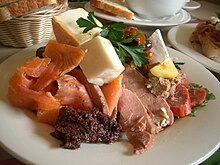Antipasto: Difference between revisions
clean up, typos fixed: constatly → constately using AWB |
m proper link for Pâté |
||
| Line 1: | Line 1: | ||
[[Image:Antipasto al Italiana.jpg|thumb|left|Antipasto all'italiana - [[Italy|Italian]] antipasto served in a restaurant]] |
[[Image:Antipasto al Italiana.jpg|thumb|left|Antipasto all'italiana - [[Italy|Italian]] antipasto served in a restaurant]] |
||
[[File:Antipasto Platter.jpg|thumb|A [[gourmet]] antipasto platter with [[smoked salmon]], smoked chicken (underneath), [[roast beef]], [[ |
[[File:Antipasto Platter.jpg|thumb|A [[gourmet]] antipasto platter with [[smoked salmon]], smoked chicken (underneath), [[roast beef]], [[pâté]], cabana [[sausage]], [[brie]]-style cheese, [[cheddar]]-style [[Goat milk|goats milk]] [[cheese]], Jensen's red [[Washed-rind_cheese#Washed-rind|washed rind cheese]], [[olive]]s, [[tapenade]], rocket [[pesto]] (behind the dish), and tomato [[chutney]].]] |
||
'''Antipasto''' (plural '''antipasti'''), means "before the meal" and is the traditional first course of a formal [[Italian cuisine|Italian meal]]. Traditional antipasto includes [[cured meat]]s, [[olive]]s, [[peperoncini]], [[edible mushroom|mushrooms]], [[Anchovy|anchovies]], [[artichoke heart]]s, various [[cheese]]s (such as [[provolone]] or [[mozzarella]]), pickled meats and vegetables (both in oil or in vinegar). |
'''Antipasto''' (plural '''antipasti'''), means "before the meal" and is the traditional first course of a formal [[Italian cuisine|Italian meal]]. Traditional antipasto includes [[cured meat]]s, [[olive]]s, [[peperoncini]], [[edible mushroom|mushrooms]], [[Anchovy|anchovies]], [[artichoke heart]]s, various [[cheese]]s (such as [[provolone]] or [[mozzarella]]), pickled meats and vegetables (both in oil or in vinegar). |
||
Revision as of 07:51, 1 June 2012


Antipasto (plural antipasti), means "before the meal" and is the traditional first course of a formal Italian meal. Traditional antipasto includes cured meats, olives, peperoncini, mushrooms, anchovies, artichoke hearts, various cheeses (such as provolone or mozzarella), pickled meats and vegetables (both in oil or in vinegar).
The contents of an antipasto vary a lot according to regional cuisine, so it is quite possible to find in the south of Italy different preparations of saltwater fish and traditional southern cured meats (like in example soppressata - a very dry salami that undergoes a cure while constately kept under weight - or 'nduja - a particular and very hot preparation made from pork fat, meat and chilli peppers-), while in the north it will contain more different kinds of cured meats and mushrooms and probably, especially near lakes, preparations of freshwater fish.
Cheeses vary a lot according to the regional tradition too.
Many compare antipasto to hors d'oeuvre, but antipasto is served at the table and signifies the official beginning of the Italian meal. It may also be referred to as a starter, or an entrée.
See also
References
- Scicolone, Michele (1998). "The Antipasto Table". HarperCollins. Retrieved April 20, 2012. ISBN 0880016272
